
Crocus
Definition: any of a genus (Crocus) of herbs of the iris family developing from corms and having solitary long-tubed flowers and slender linear leaves
A low-growing plant with a corm, the crocus belongs to the iris family. There are about 75 species of crocus. They are native to the Alps, southern Europe, and the Mediterranean and are widely grown for their cuplike blooms in early spring or fall. The spring-flowering sorts have a floral tube so long that the ovary is below ground, sheltered from climatic changes. The word crocus comes, via Middle English and Latin, from the Greek word krokos, meaning “saffron plant,” and indeed saffron comes from a species of crocus that is native to western Asia, while alpine crocus is the chief ancestor of the common garden crocus.
Right before the entrance to the park was the large white house with the wheelbarrow full of flowers. Short crocus blades sheathed the purple-and-white hearts that so wished to be the first they endured the chill and rain of early spring.
— Toni Morrison, The Bluest Eye (1970)

Tulip
Definition: any of a genus (Tulipa) of Eurasian bulbous herbs of the lily family that have linear or broadly lanceolate leaves and are widely grown for their showy flowers
In addition to being a beloved reminder and herald of spring, tulips are often associated—as the quote from bell hooks below attests—with northern Europe, and Holland in particular. Holland, after all, was the epicenter of tulipomania, a speculative frenzy that enveloped the region the 17th century. The natural range of the flower, however, lies to the south and east, encompassing parts of southern Spain and Portugal, the Mediterranean coast of several African nations, Sicily, Greece, and much of the Middle East and central Asia. The word tulip reveals a bit of the flower’s geographic origins as well, tracing back via New Latin from the Turkish word for “turban,” tülbent, which in turn comes from the Persian dulband.
Every time she comes to visit she brings flowers. Naturally my favorites are tulips, and naturally the best, the most wonderful tulips can be found in Holland.
— bell hooks, Wounds of Passion: A Writing Life (1997)

Coltsfoot
Definition: a perennial composite herb (Tussilago farfara) with yellow flower heads appearing before the leaves
Coltsfoot is often mistaken for dandelion; both originated in Europe and Asia but have become widely naturalized in North America, and both bear bright yellow flower heads. But coltsfoot is easily distinguished by its lack of leaves—at least when it first emerges in early spring along a river or road. The common name coltsfoot is also given to a number of other plants bearing leaves thought to be shaped like a colt’s feet. Coltsfoot’s genus name, Tussilago comes from the Latin word for cough, tussis, likely from the plant’s use in traditional medicine as a cough remedy.
She taught me one of the cardinal rules of gathering plants: “Never take the first plant you find, as it might be the last—and you want that first one to speak well of you to the others of her kind.” That’s not too hard to do when you come upon a whole stream bank of coltsfoot, when there’s a third and a fourth right behind the first, but it’s harder when the plants are few and the desire is great.
— Robin Wall Kimmerer, Braiding Sweetgrass (2013)
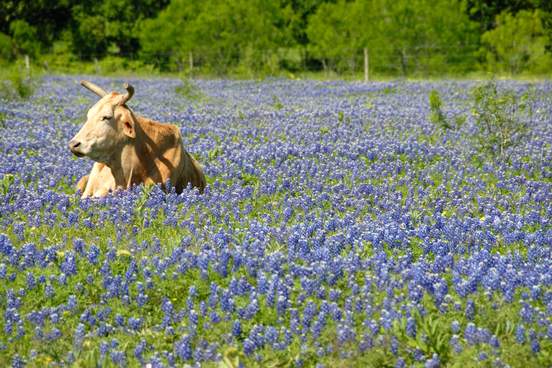
Bluebonnet
Definition: either of two low-growing annual lupines (Lupinus subcarnosus or L. texensis) of Texas with silky foliage and blue flowers
One of our editors, a Texan, has this to say about bluebonnets: “as early as February, as late as April; they’ll tell you what kind of spring weather to expect.” Wonderful! But also this: “People like to pull off the side of the highway and pose their kids and dogs in these lovely fields for pretty pics… don’t do that! Google ‘bluebonnet’ + ‘snake bite’ for more on this.” Not as wonderful! The origins of the common name for these enticing-yet-snake-concealing flowers is intuitive enough: bluebonnet petals do indeed resemble blue bonnets. As bluebonnets are lupines (they belong to the genus Lupinus), you may be interested to know that lupine comes ultimately from the Latin lupus, meaning “wolf.”
There was a bitterness between the men that lasted decades. Joe sent a postcard or two over the years. But the only ones available in Shelby County, Texas, showed pictures of Lone Stars or live oaks, bluebonnets and scenes of prairie and cattle, and that did nothing to douse the hot embers of resentment Booker felt about losing the best guitar player he ever knew—a man he considered a brother and a friend—to rural Texas.
— Attica Locke, Bluebird, Bluebird (2017)

Phoebe
Definition: any of a genus (Sayornis) of the tyrant flycatcher family; especially a flycatcher (S. phoebe) of the eastern U.S. that has a slight crest and is plain grayish brown above and yellowish white below
Depending on where one lives in the United States, different bird species may signal the arrival of spring in earnest. The widespread American robin, for one, is often celebrated as a spring herald, even though its year-round range covers most of the lower 48 states. In many parts of the northern states, the lesser-known but highly populous phoebe is another. This flycatcher—similar in appearance to its kin including the wood-pewee and eastern kingbird—is named after its call, a scratchy, impertinent “fee-bee!” whose spelling was perhaps influenced by that of the Greek goddess, Phoebe, aka Artemis. The phoebe is also identifiable by its custom of bobbing its tail when perched.
Phoebes like nesting in wooded yards and in human-made structures, wherever they might find a sheltered ledge. Even in northern areas, Eastern Phoebes can start building nests in late March…
— Margaret A. Barker and Elissa Ruth Wolfson, The Birdhouse Book (2021)
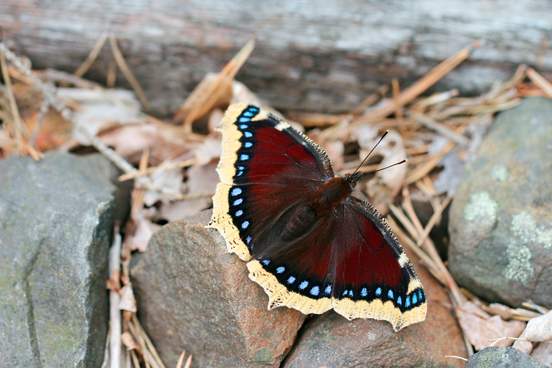
Mourning cloak
Definition: a blackish-brown nymphalid butterfly (Nymphalis antiopa) that has a broad yellow border on the wings and is found in temperate parts of Europe, Asia, and North America
Not being as large or bright as famous butterfly species such as the monarch, the mourning cloak may go undetected as a vernal harbinger, but if you happen to be out and about in early spring and your eye see something flutter by, take a closer look—you may be graced by a mourning cloak. This butterfly was given its name due to the resemblance of its deep brown wings to the color and texture of cloth worn by those in mourning.
Because they overwinter as adults, protectively hidden under loose tree bark, and because they have no metamorphosis to undergo, mourning cloaks are one of the first butterflies to be observed in the spring.
— Mary Holland, Naturally Curious (2010)
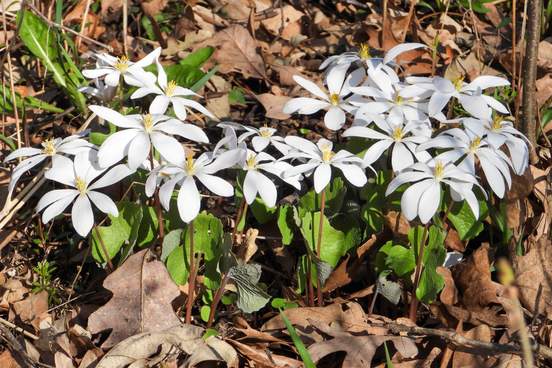
Bloodroot
Definition: a plant (Sanguinaria canadensis) of the poppy family having a red root and sap and bearing a solitary lobed leaf and white flower in early spring
Bloodroot has gone by many names in English over the centuries, including sanguinaria, redroot, tetterwort, bloodwort, and even turmeric. Many of the names arose due to the plant’s medicinal properties, but others—including bloodroot, refer to its red root and sap. Bloodroot flowers bloom briefly in early spring before the tree canopy closes and shades it out, though its leaves persist later into the year.
Enslaved herbalists had intimate knowledge of hundreds of native and naturalized plants, including snakeroot, mayapple, red pepper, boneset, pine needles, comfrey, pokeweed, sassafras, goldenseal, belladonna, lobelia, sage, henna, rhubarb, bloodroot, wild cherry, jimsonweed, peppermint, saffron, pleurisy, horehound, elecampane, skunk cabbage, spikenard root, Alexandria senna, catnip, High John root, pennyroyal, and red oak bark. Black herbalists understood the physical healing properties of these plants as well as their spiritual dimension.
— Leah Penniman, Farming While Black (2018)
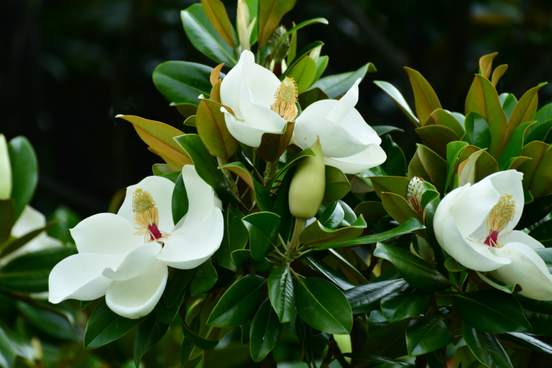
Magnolia
Definition: any of a genus (Magnolia of the family Magnoliaceae, the magnolia family) of American and Asian shrubs and trees with entire evergreen or deciduous leaves and usually showy white, yellow, rose, or purple flowers usually appearing in early spring
Though magnolias belong to an ancient family of flowering plants, Magnoliaceae, the word magnolia is only a few centuries old, coined for French botanist Pierre Magnol. Although the fossil record indicates that the family was once widely distributed in Eurasia and North America, it is now concentrated in the southeastern United States, Mexico, Central America, the Caribbean, and in East and Southeast Asia, with only a few species in the Southern Hemisphere.
On the bed stand, a sprig of magnolia expands like a secret heard / for the first time.
— Ocean Vuong, “Aubade with Burning City,” Night Sky with Exit Wounds (2016)
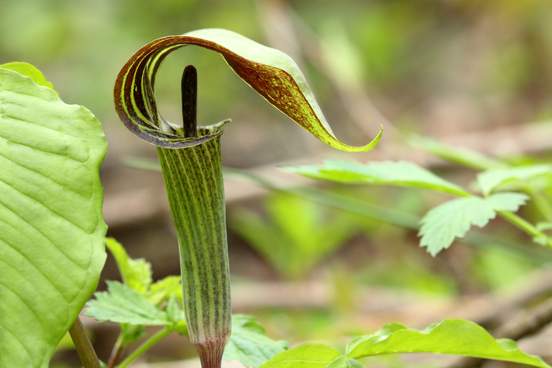
Jack-in-the-pulpit
Definition: a North American spring-flowering woodland herb (Arisaema triphyllum synonym A. atrorubens) of the arum family having an upright club-shaped spadix arched over by a green and purple spathe
The noun jack has many varied meanings. It can, for instance, refer to a category of playing card; a device used to lift something heavy; a small opening where something connects with a wire to something else; a small six-pointed object used to play a game; in plural form, that game itself; anything at all—a use that typically appears in negative statements: you don’t know jack.
The word jack has been with us since the days of Middle English, when Jacke was used as a familiar term of address for a social inferior. Even then it was also a nickname, at the time for Johan, the Middle English version of “John.” In modern English it is historically a nickname for John (President John F. Kennedy was “Jack Kennedy” to his familiars) but in recent decades it has been commonly used as a full name by itself.
The corollary of the name “Jack” is often “Jill,” and as individual jack-in-the-pulpits can be female, some people refer to the latter as jill-in-the-pulpit. Males typically have a single leaf featuring three leaflets, while female plants sprout two leaves. Take note, however, that from year-to-year, “jacks”-in-the-pulpit can change to “jills” and “jills” to “jacks”:
Of course, not all the flowers are “Jacks;” some of them are “Jills.” And last year’s Jill could very well be this year’s Jack—and vice versa. Jack-in-the-pulpits change sex from year to year based on how much energy a plant contains in its corm, a bulbous underground stem that stores the plant’s carbohydrates.
— Meghan McCarthy McPhaul, Northern Woodlands, 20 June 2016
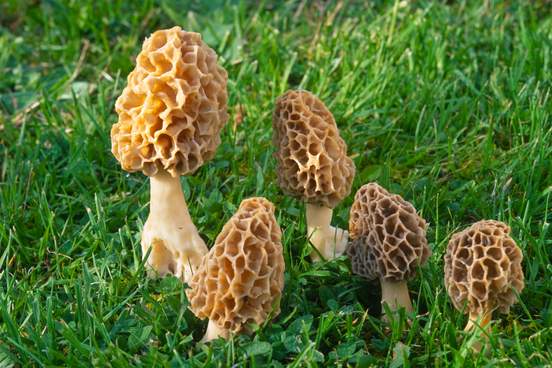
Morel
Definition: any of several edible fungi (genus Morchella, especially M. esculenta) having a conical cap with a highly pitted surface
Morels are some of the most prized edible mushrooms in the world—indeed, at least one humble lexicographer out there can attest that they are truly delicious in an omelet. They are also—due to myriad heretofore only partially understood ecological associations and requirements—exceedingly difficult to grow commercially, adding to their culinary cachet. In some locations their fruiting bodies only appear for brief windows of time in the spring, and in the vicinity of particular tree species such as ash, apple, and elm. The English word morel comes from the French morille, which in turn comes the Vulgar Latin maurus, meaning “brown.”
She sat at a stool to do this minor but careful work. Passing the brush around the button caps and across the tender gills of the oyster mushrooms. The morels like something out of a fairy tale.
— Brandon Taylor, The Late Americans (2023)
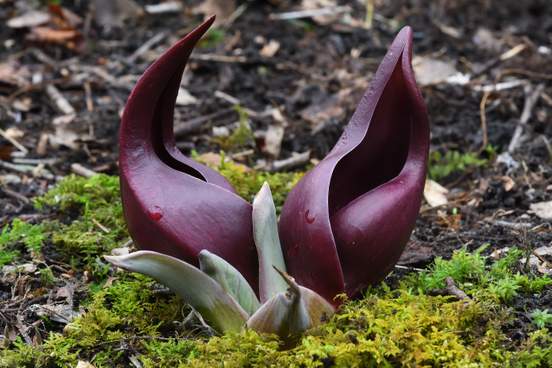
Skunk cabbage
Definition: any of several early-blooming perennial herbs of the arum family that occur in shaded, wet to swampy areas and have a fetid odor suggestive of a skunk
Relatives of jack-in-the-pulpit, skunk cabbages also feature showy spathes enclosing spadices, but are decidedly stinkier. So stinky, in fact, that their odor has been likened to the “secretion of pungent and offensive odor” ejected from the perineal glands of a certain fuzzy bicolor mammal. The word skunk comes from squuncke, in turn from a Massachusett reflex of the Algonquian word *šeka·kwa, from šek- (“urinate”) + -a·kw (“fox, fox-like animal”).
On rare warm days in late winter, flies may visit, or honeybees may occasionally venture out of their hives in search of pollen or nectar. To increase the likelihood of a visit by one of these intrepid insects, skunk cabbage can generate its own heat by a rapid method of respiration.
— Carol Gracie, Florapedia (2021)
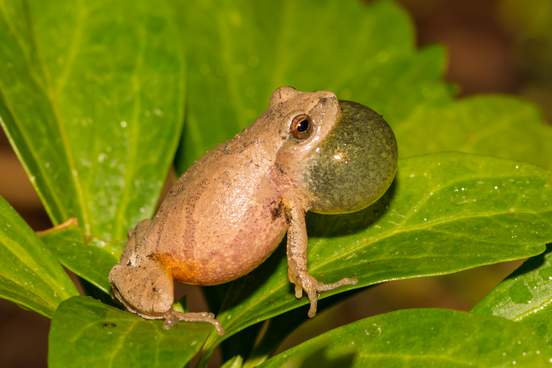
Spring peeper
Definition: a small brown tree frog (Pseudacris crucifer synonym Hyla crucifer) of the eastern U.S. and Canada that has a shrill piping call and breeds in ponds and streams in the spring
Spring peepers, often just called peepers start singing on some of the earliest warm spring nights, ushering in the season with an evocative chorus. While they are highly successful in permanent ponds, they also utilize temporary, ephemeral ponds that appear briefly in the spring due to rain and snowmelt.
Peepers’ high-pitched, somewhat cricket-like peeps can be heard at a time when few or no insects are sounding off—on warmer late winter and early spring evenings. Choruses of these frogs take place along wetland edges and in swamps and even in the city can be heard from at least several hundred yards away.
— Howard Youth, Field Guide to the Natural World of Washington D.C. (2014)





